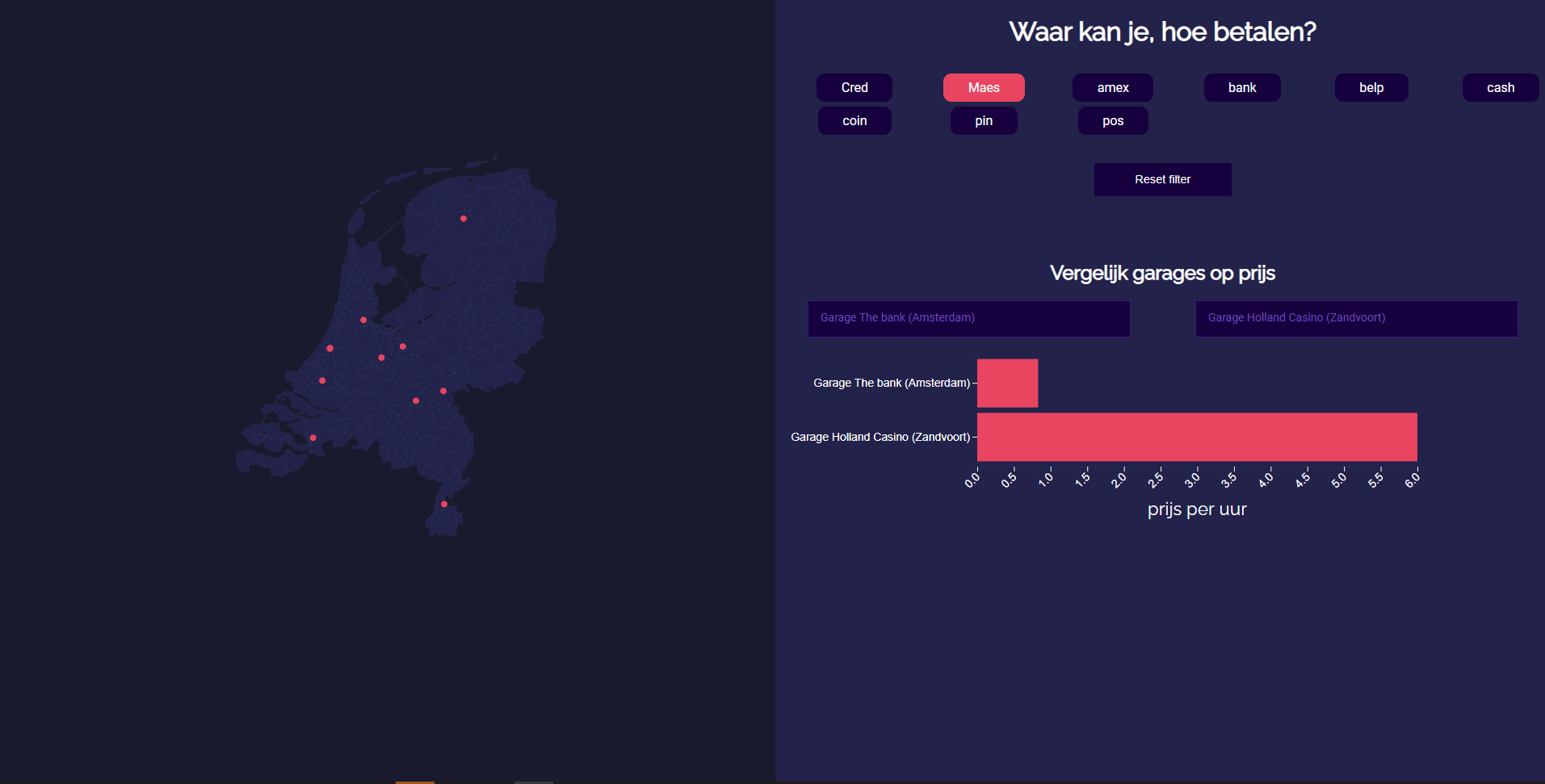Final product link
First product link
Volkskrant assignment
For the Volkskrant, we are having a look into the RDW datasets that are provided to find interesting insights for a potential article about parking, where it is all about cars.
The assignment is to filter and find connections with different datasets where 'parking' (cars) is the middle word for each of these datasets, one head question can be answered by the datasets. The main goal of this assignment is to link interesting links with each other and to filter data out of the available datasets
This wiki also contains assignments apart from the volkrant, these are practice datasets that were filled in by the students that are following the course: datavizualisation.
Concept
Making a geographical map for parking places where you can see how much you need to pay for a certain parking place and how much it cost per hour also I am going to note down how you can pay the parking fee (cash, banknotes, VISA etc)
Research question
How can you pay at a specific parking garage (by card, coins, banknotes, visa etc.)
- Are there more parking garages where you can pay by card in 2020?
- Are there still parking garages where you can pay by coins/banknotes
Sub questions
- Are there parking areas where you can pay with cryptocoins?
- How far apart are the payment terminals in a particular parking area?
- Are the payment machines wheelchair-proof (height of machines)?
- Where can you still pay with cash at a payment terminal?
- How are the payment methods (cash, pin) distributed throughout the city? Center more pin options than outside the center?
Datasets needed
- https://data.overheid.nl/dataset/11389-open-data-parkeren--betaalmethode-gebied (areaid, paymentmethod)
- https://opendata.rdw.nl/Parkeren/Open-Data-Parkeren-GEBIED/adw6-9hsg (not sure yet if I am going to use this one)
- https://opendata.rdw.nl/Parkeren/GEO-Parkeer-Garages/t5pc-eb34 (areaid, Location, AreaDesc)
- https://opendata.rdw.nl/Parkeren/Open-Data-Parkeren-TARIEFDEEL/534e-5vdg (From peer-feedback)
The primary key (PK) in these datasets is : areaid, with this key I am able to find other datasets with this value to join each other
Assumptions
- There are more parking spots where you can pay by card then with coins or banknotes
- Parking spots closer to the city centre have more payment options and are more expensive than ones further away
What's done with invalid or empty values?
During developing I needed to combine datasets with eachother, during the combining some values were lost and I've decided the keep it that way, beacuse there was no way I was able to use this data because it didn't contained the values that I needed.
Looking for a shareable component template? Go here --> sveltejs/component-template
svelte app
This is a project template for Svelte apps. It lives at https://github.com/sveltejs/template.
To create a new project based on this template using degit:
npx degit sveltejs/template svelte-app
cd svelte-app
Note that you will need to have Node.js installed.
Get started
Install the dependencies...
cd svelte-app
npm install
...then start Rollup:
npm run dev
Navigate to localhost:5000. You should see your app running. Edit a component file in src, save it, and reload the page to see your changes.
By default, the server will only respond to requests from localhost. To allow connections from other computers, edit the sirv commands in package.json to include the option --host 0.0.0.0.
If you're using Visual Studio Code we recommend installing the official extension Svelte for VS Code. If you are using other editors you may need to install a plugin in order to get syntax highlighting and intellisense.
Building and running in production mode
To create an optimised version of the app:
npm run build
You can run the newly built app with npm run start. This uses sirv, which is included in your package.json's dependencies so that the app will work when you deploy to platforms like Heroku.
Single-page app mode
By default, sirv will only respond to requests that match files in public. This is to maximise compatibility with static fileservers, allowing you to deploy your app anywhere.
If you're building a single-page app (SPA) with multiple routes, sirv needs to be able to respond to requests for any path. You can make it so by editing the "start" command in package.json:
"start": "sirv public --single"
Using TypeScript
This template comes with a script to set up a TypeScript development environment, you can run it immediately after cloning the template with:
node scripts/setupTypeScript.js
Or remove the script via:
rm scripts/setupTypeScript.js
Deploying to the web
With Vercel
Install vercel if you haven't already:
npm install -g vercel
Then, from within your project folder:
cd public
vercel deploy --name my-project
With surge
Install surge if you haven't already:
npm install -g surge
Then, from within your project folder:
npm run build
surge public my-project.surge.sh
Sketches
First product screenshot(s)
Final product screenshot(s)
License
Authtor: RowinRuizendaal
license: MIT
Credits
vuurvos1 For the good coding talks in Discord ༼ つ ◕_◕ ༽つ and the helpfull help
sreen020 For working together in Vizhub
Vizhub tries
Resources
Arora, S. (2019, March 27). Understanding Higher-Order Functions in JavaScript - Bits and Pieces. Medium. https://blog.bitsrc.io/understanding-higher-order-functions-in-javascript-75461803bad
Elliott, E. (2019, July 2). Master the JavaScript Interview: What is Functional Programming? Medium. https://medium.com/javascript-scene/master-the-javascript-interview-what-is-functional-programming-7f218c68b3a0
Open Data | | Open Data. (n.d.). RDW. Retrieved October 29, 2020, from https://opendata.rdw.nl/


